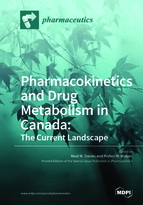Pharmacokinetics and Drug Metabolism in Canada: The Current Landscape
A special issue of Pharmaceutics (ISSN 1999-4923).
Deadline for manuscript submissions: closed (20 December 2017) | Viewed by 171906
Special Issue Editors
Interests: pharmacokinetics; chirality; drug interactions; formulation and drug delivery
Special Issues, Collections and Topics in MDPI journals
Interests: pharmaceutics; drug delivery; formulation; drug development; translational pharmacotherapy; lipid and lipoprotein metabolism; pharmacokinetics
Special Issues, Collections and Topics in MDPI journals
Special Issue Information
Dear Colleagues,
Canadian Pharmaceutical Scientists have a rich history of ground-breaking research in pharmacokinetics and drug metabolism undertaken throughout its Pharmacy and Medical Schools and within the Pharmaceutical and biotechnology industry. The principle of drug Absorption, Distribution, Metabolism and Excretion (ADME) is the foundational basis of rationale drug-design, and pharmacotherapy. The study of ADME and its descriptive quantitative analysis is the basis of pharmacokinetics. Pharmacokinetics is fundamental in the development of a new chemical entity into a marketable product and is essential in understanding the bioavailability, bioequivalence and biosimilarities of drugs. Pharmacokinetics and drug development studies facilitate an understanding of organ-based functionality. Population pharmacokinetic variability and the modeling of drug concentrations has significant utility in translating individual response in a target patient population.
This special issue serves to highlight and capture the contemporary progress and current landscape of pharmacokinetics and drug metabolism within the prevailing Canadian context. We invite articles on all aspects of Pharmacokinetics and Drug Metabolism studies highlighting the world-class research currently undertaken in Canada for this special issue.
Prof. Dean, Dr. Neal M. Davies
Prof. Dean, Dr. Kishor M. Wasan
Guest Editors
Manuscript Submission Information
Manuscripts should be submitted online at www.mdpi.com by registering and logging in to this website. Once you are registered, click here to go to the submission form. Manuscripts can be submitted until the deadline. All submissions that pass pre-check are peer-reviewed. Accepted papers will be published continuously in the journal (as soon as accepted) and will be listed together on the special issue website. Research articles, review articles as well as short communications are invited. For planned papers, a title and short abstract (about 100 words) can be sent to the Editorial Office for announcement on this website.
Submitted manuscripts should not have been published previously, nor be under consideration for publication elsewhere (except conference proceedings papers). All manuscripts are thoroughly refereed through a single-blind peer-review process. A guide for authors and other relevant information for submission of manuscripts is available on the Instructions for Authors page. Pharmaceutics is an international peer-reviewed open access monthly journal published by MDPI.
Please visit the Instructions for Authors page before submitting a manuscript. The Article Processing Charge (APC) for publication in this open access journal is 2900 CHF (Swiss Francs). Submitted papers should be well formatted and use good English. Authors may use MDPI's English editing service prior to publication or during author revisions.
Related Special Issues
- Pharmaceutical Sciences in Canada in Pharmaceutics (41 articles)
- Advanced Pharmaceutical Science and Technology in Pharmaceutics (3 articles)








